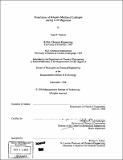Regulation of integrin-mediated linkages during cell migration
Author(s)
Palecek, Sean Paul
DownloadFull printable version (11.65Mb)
Advisor
Douglas A. Lauffenburger.
Terms of use
Metadata
Show full item recordAbstract
The objective of this study was to determine how integrin adhesion interact with both cytoskeletal elements and ligands to determine cell migration speed. An understanding of these parameters will aid in developing methods to control cell migration to treat diseases such as cancer, to aid wound healing, or to design tissue engineering matrices. A Chinese hamster ovary (CHO) cell system was constructed to allow us to vary integrinligand binding by altering extracellular matrix (ECM) concentration, integrin expression level, and integrin-ligand binding. As these parameters change, cell migration speed remains a constant, biphasic function of cell-substratum adhesiveness. We can regulate cell speed by varying the number and nature of cell-substratum bonds. The mechanism of cell-substratum detachment is also different as cell adhesiveness varies. At low adhesiveness integrin-ECM bonds preferentially dissociate while at high adhesiveness integrin-cytoskeletal linkages fracture and rear retraction occurs by extraction of ligand-bound integrin from the cell membrane. At high adhesiveness cellsubstratum detachment is the rate-limiting step in cell migration speed while at low adhesiveness other factors, such as the formation of new adhesions, are likely to limit cell speed. We identified calpain, a calcium-dependent protease, as a regulator of rear retraction and cell speed at high adhesiveness. Calpain inhibition strengthens integrin-cytoskeletal linkages and greatly reduces integrin-extraction during rear retraction. These experiments demonstrate that we can change cell speed by altering how integrins interact with both the ECM and cytoskeleton. A mathematical model of rear retraction during cell migration was developed to help explain how integrin-ECM and integrin-cytoskeleton binding 'can regulate retraction rate and mechanism. The model predicts two different detachment phenotypes. Rear retraction can occur by either rapid release of integrin-ECM bonds or by slower cleavage of integrin-cytoskeletal linkages followed by extraction of integrin from the cell membrane. Rapid detachment rate is regulated by integrin-ligand affinity and concentrations while slow detachment is regulated by integrin-cytoskeleton binding and calpain activity. The transition from slow to rapid detachment can be induced by reducing integrin-ligand affinity, increasing integrin-ligand concentration ratio, or increasing intracellularly generated force. This model can explain why highly motile cells do not release integrin during rear retraction but slower cells tend to detach by integrin extraction.
Description
Thesis (Ph.D.)--Massachusetts Institute of Technology, Dept. of Chemical Engineering, 1998. Includes bibliographical references.
Date issued
1998Department
Massachusetts Institute of Technology. Department of Chemical EngineeringPublisher
Massachusetts Institute of Technology
Keywords
Chemical Engineering